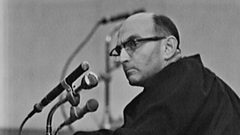
How the world was educated about Auschwitz through the trial of Adolf Eichmann?
Understanding how the trial of Adolf Eichmann was used as an educational tool.
A witness sits in the stand at the trial of Adolf Eichmann. He face is almost impassive and drained of colour. She recalls in staccato detail how at Auschwitz her five year old child in her arms began to cry, was ripped from her and shot. She was one of over 100 witnesses, 16,000 documents and 56 days of prosecution evidence presented against Adolf Eichmann at his trial in Jerusalem that was described as βa comprehensive record, a giant human and national disaster.β Specialist analysis is presented by historian Prof David Cesarani who discusses the power of opening statement of the lead prosecutor, Gidon Hausner, who stated, βI am speaking in the name of six million who are not here to accuse you because you killed them.β This, Professor Cesarani points out, was the main thrust of the prosecution argument against Adolf Eichmann. Eichmann managed to escape Europe at the end of the war and was later found in Argentina under the assumed name of Riccardo Clement. He was tracked down and snatched by Israeli agents and put on trial for crimes against Jews. Yehuda Bakon recalls how the trial was a turning-point for survivors who now found that their experiences and testimony were being taken seriously for the first time. He recalls how victims brought to the death camps victims were duped and calmed right through their selection and processing to their deaths in Auschwitz. He discusses how the gas chambers had false shower heads βto bluff youβ until that last moment and how those people who were unwell and infirm were brought to the doors of the gas chambers on a slide, dumped into the cavern of death. Gabriel Bachβs story of one survivor of Auschwitz and trial witness recalling the moment their family disappeared from their eyes after arriving in a transport in May 1944. He recalls how the survivorβs daughter was wearing a red coat and he watched her until she was a vanishing dot in the crowd, a scene made famous in Steven Spielbergβs Schindlerβs List. βThis is how my family disappeared from my life.β The clip finishes with the testimony of Yehiel Dinur being asked to describe Auschwitz which he depicts as another planet before collapsing at the stand and being taken out of the court room on a stretcher.
Duration:
This clip is from
More clips from The Eichmann Show Documentary
-
![]()
How far can one person be held responsible for the Holocaust?
Duration: 06:06
-
![]()
The Eichmann Trial and the State of Israel
Duration: 05:34
-
![]()
Managing evidence and recording the trial of Adolf Eichmann
Duration: 05:30
-
![]()
Who was Adolf Eichmann?
Duration: 05:53





